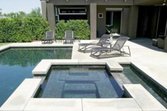
If you’re already building a pool, the added amenity of an in-ground spa can make economic sense.
Once you’ve decided to install a pool, tacking on the additional amenity of an in-ground spa often makes economic sense. After all, builders are already digging up your yard. And because the spa uses the same plumbing and mechanical systems, it’s cheaper to do it now than to add it later.
Expect to pay an additional $10,000 to $15,000 for a custom-built, eight-person spa. For about half that cost, you can buy and install a portable hot tub, a good option if you want the spa experience without the expense and hassle of backyard construction. There are a few considerations that are different between a pool and spa, most having to do with the maintenance demands of hot water. One thing is the same, though. Like a pool, an in-ground spa won’t necessarily add to the value of your home.
Spa placement affects cost
There’s almost no limit to what you can spend on spa aesthetics. Since it’s a smaller structure, people often splurge on fancy finishes like glass tile, which can as much as double the price tag. Because the pool and spa rely on the same plumbing and mechanical systems, the final cost depends in large part on how far the builder has to run utilities to the spa. Increasingly, spas are integrated right into the pool itself, elevated on platforms or incorporated into waterfall designs.
Go aboveground for a less expensive option
If all you really want is a warm soak, you can install a portable spa with—or without—an in-ground pool and take it with you when you move, just like the patio furniture. Portable spas, usually referred to as hot tubs, deliver more robust water therapy than in-ground spas, since it’s easier to incorporate extra jets and massage features into freestanding units.
Reliable, quality hot tubs that roll onto your deck or patio start at $4,000 for a 4- to 6-person unit. You will need dedicated wiring, the same way your dishwasher and air-conditioning units require their own circuits, but installation is a plug-and-play proposition for a licensed electrician.
If you go this route, keep in mind that a fully loaded hot tub is heavy. To figure out just how heavy, multiply the amount of water it holds by 8 pounds per gallon, then add that to the listed weight of the tub itself. You will need a level spot able to handle the load. Most decks aren’t designed to carry that kind of weight, so you may have to consult a structural engineer about reinforcement. If you’re installing it on grade, manufacturers recommend a reinforced concrete pad at least four inches thick.
Hot water means higher maintenance
Because of a spa’s high temperature—typically 99 to 104 degrees Fahrenheit—you’re even more on the hook to stay on top of the water chemistry than with a pool. The pH tends to drift upward, so it’s not uncommon to test and balance as often as three times a week. You’ll want to check the levels after each use, too, since each bather loses more than a liter of body fluids in a 30-minute soak.
On the other hand, at only 300 to 500 gallons of water, you’ll spend less on chemicals. For a chlorine system, the total maintenance commitment is no more than $100 a year. You’ll need to spend a little extra on scale resisters, since warm water has a tendency to drop out calcium and magnesium, which form deposits on the pool heater. Add 10% to your maintenance budget if your pool uses a salt chlorinator system. Because the pool and spa share the same mechanicals, they must also use the same chemicals.
One bit of maintenance good news: If you make a big mistake with chemicals, you can always dump the water and start again. Just try that with a swimming pool.



